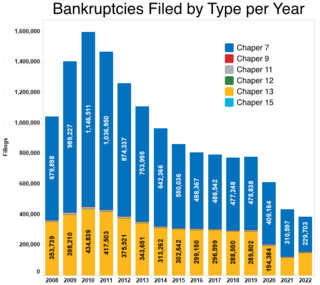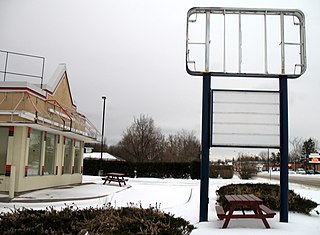Related Research Articles
Bankruptcy is a legal process through which people or other entities who cannot repay debts to creditors may seek relief from some or all of their debts. In most jurisdictions, bankruptcy is imposed by a court order, often initiated by the debtor.
Chapter 7 of Title 11 U.S. Code is the bankruptcy code that governs the process of liquidation under the bankruptcy laws of the U.S. In contrast to bankruptcy under Chapter 11 and Chapter 13, which govern the process of reorganization of a debtor, Chapter 7 bankruptcy is the most common form of bankruptcy in the U.S.
Personal bankruptcy law allows, in certain jurisdictions, an individual to be declared bankrupt. Virtually every country with a modern legal system features some form of debt relief for individuals. Personal bankruptcy is distinguished from corporate bankruptcy.
A creditor or lender is a party that has a claim on the services of a second party. It is a person or institution to whom money is owed. The first party, in general, has provided some property or service to the second party under the assumption that the second party will return an equivalent property and service. The second party is frequently called a debtor or borrower. The first party is called the creditor, which is the lender of property, service, or money.

In the United States, bankruptcy is largely governed by federal law, commonly referred to as the "Bankruptcy Code" ("Code"). The United States Constitution authorizes Congress to enact "uniform Laws on the subject of Bankruptcies throughout the United States". Congress has exercised this authority several times since 1801, including through adoption of the Bankruptcy Reform Act of 1978, as amended, codified in Title 11 of the United States Code and the Bankruptcy Abuse Prevention and Consumer Protection Act of 2005 (BAPCPA).

In accounting, insolvency is the state of being unable to pay the debts, by a person or company (debtor), at maturity; those in a state of insolvency are said to be insolvent. There are two forms: cash-flow insolvency and balance-sheet insolvency.
A trustee in bankruptcy is an entity, often an individual, in charge of administering a bankruptcy estate.
A bankruptcy discharge is a court order that releases an individual or business from specific debts and obligations they owe to creditors. In other words, it's a legal process that eliminates the debtor's liability to pay certain types of debts they owe before filing the bankruptcy case.
Bankruptcy in the United Kingdom is divided into separate local regimes for England and Wales, for Northern Ireland, and for Scotland. There is also a UK insolvency law which applies across the United Kingdom, since bankruptcy refers only to insolvency of individuals and partnerships. Other procedures, for example administration and liquidation, apply to insolvent companies. However, the term 'bankruptcy' is often used when referring to insolvent companies in the general media.

The Bankruptcy and Insolvency Act is one of the statutes that regulates the law on bankruptcy and insolvency in Canada. It governs bankruptcies, consumer and commercial proposals, and receiverships in Canada.
An individual voluntary arrangement (IVA) is a formal alternative in England and Wales for individuals wishing to avoid bankruptcy. In Scotland, the equivalent statutory debt solution is known as a protected trust deed.
Bankruptcy is a legally declared inability or impairment of ability of an individual or organization to pay their creditors. In most cases personal bankruptcy is initiated by the bankrupt individual. Bankruptcy is a legal process that discharges most debts, but has the disadvantage of making it more difficult for an individual to borrow in the future. To avoid the negative impacts of personal bankruptcy, individuals in debt have a number of bankruptcy alternatives.
An undervalue transaction is a transaction entered into by a company who subsequently goes into bankruptcy which the court orders be set aside, usually upon the application of a liquidator for the benefit of the debtor's creditors. This can occur where the transaction was seriously disadvantageous to the company and the company was insolvent or in immediate risk of becoming insolvent.
A general assignment or assignment is a concept in bankruptcy law in which an insolvent entity's assets are assigned to someone as an alternative to a bankruptcy. One form is an "assignment for the benefit of creditors", abbreviated ABC or AFBC.
The Parliament of Canada has exclusive jurisdiction to regulate matters relating to bankruptcy and insolvency, by virtue of Section 91(2) of the Constitution Act, 1867. It has passed the following statutes as a result:
Bankruptcy in Irish Law is a legal process, supervised by the High Court whereby the assets of a personal debtor are realised and distributed amongst his or her creditors in cases where the debtor is unable or unwilling to pay his debts.

Commercial insolvency in Canada has options and procedures that are distinct from those available in consumer insolvency proceedings. It is governed by the following statutes:
Insolvency in South African law refers to a status of diminished legal capacity imposed by the courts on persons who are unable to pay their debts, or whose liabilities exceed their assets. The insolvent's diminished legal capacity entails deprivation of certain of his important legal capacities and rights, in the interests of protecting other persons, primarily the general body of existing creditors, but also prospective creditors. Insolvency is also of benefit to the insolvent, in that it grants him relief in certain respects.

British Virgin Islands bankruptcy law is principally codified in the Insolvency Act, 2003, and to a lesser degree in the Insolvency Rules, 2005. Most of the emphasis of bankruptcy law in the British Virgin Islands relates to corporate insolvency rather than personal bankruptcy. As an offshore financial centre, the British Virgin Islands has many times more resident companies than citizens, and accordingly the courts spend more time dealing with corporate insolvency and reorganisation.
Anguillan bankruptcy law regulates the position of individuals and companies who are unable to meet their financial obligations.
References
- ↑ "Bankruptcy and Insolvency Act (R.S.C., 1985, c. B-3)" . Retrieved September 5, 2011.
- ↑ "BIA, S. 49(1)" . Retrieved March 25, 2017.
- ↑ "BIA, S. 43(1)" . Retrieved March 25, 2017.
- ↑ "BIA, S. 57" . Retrieved March 25, 2017.
- ↑ "Initiation of Bankruptcy Process, Bankruptcy Lawyers' Guide".
- ↑ "Alternatives to Bankruptcy. Consumer Proposal, Bankruptcy Lawyers Guide,http://www.lawyersbankruptcy.ca/consumer_proposal.html" . Retrieved August 24, 2014.
- ↑ "BIA, S. 66.12(1)". Archived from the original on September 30, 2011. Retrieved September 16, 2011.
- ↑ "BIA, S. 50(1)" . Retrieved September 16, 2011.
- ↑ "BIA, S. 50.4(1)" . Retrieved September 16, 2011.
- ↑ "BIA, S. 42(1)(i)" . Retrieved September 16, 2011.
- ↑ "BIA, S. 49(1)" . Retrieved September 16, 2011.
- ↑ "BIA, S. 43(1)" . Retrieved September 16, 2011.
- ↑ "BIA, S. 69(1)". Archived from the original on October 12, 2011. Retrieved September 16, 2011.
- ↑ "Bankruptcy: Duties of the Bankrupt". Bankruptcy Lawyers.
- ↑ "BIA, S. 158". Archived from the original on October 10, 2011. Retrieved September 16, 2011.
- ↑ "BIA, S. 68". Archived from the original on December 4, 2011. Retrieved September 16, 2011.
- ↑ "BIA, S. 67(1)(b.3)" . Retrieved September 16, 2011.
- ↑ "Bankruptcy Exemptions by Province or Territory in Canada". Findependence Day. Retrieved February 22, 2022.
- ↑ "Bankruptcy Discharge: Absolute, Conditional Discharges". Bankruptcy Lawyers.
- ↑ "BIA, S. 172". Archived from the original on 2012-02-21. Retrieved 2011-09-15.
- ↑ "BIA, S. 157.1". Archived from the original on 2011-10-10. Retrieved 2011-09-15.
- ↑ "BIA, S. 168.1". Archived from the original on 2011-10-12. Retrieved 2011-09-15.
- ↑ "BIA, S. 172.1". Archived from the original on 2012-02-21. Retrieved 2011-09-15.
- ↑ "Defense of Fraudulent Conveyances". Bankruptcy Lawyers.
- ↑ "BIA, S. 178(1)".
- ↑ "BIA, S. 178(1.1)".
- ↑ "Bankruptcy and Insolvency Records Search". Government of Canada. Retrieved December 6, 2018.